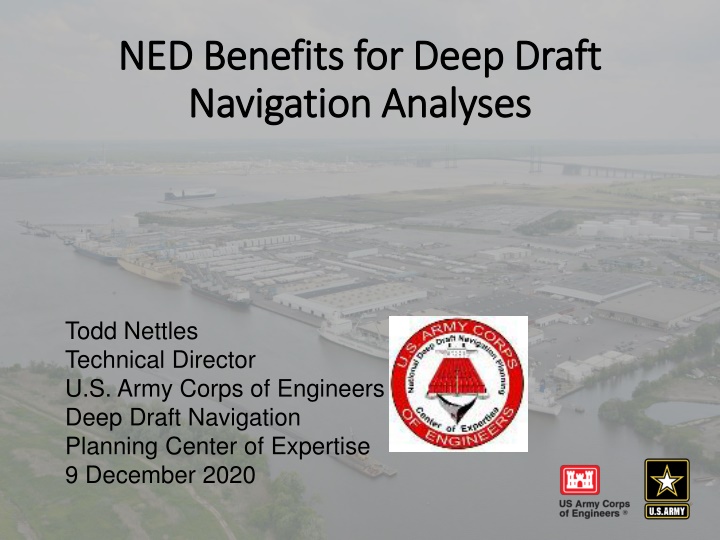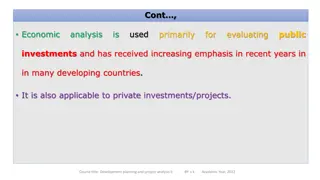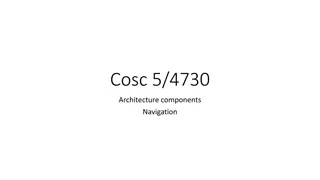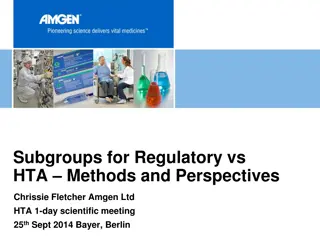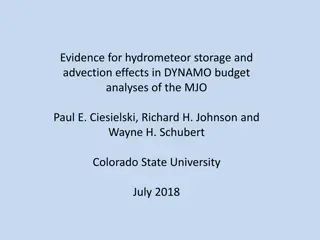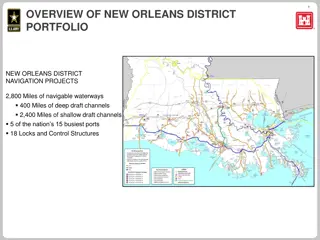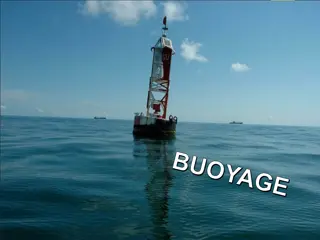Deep-Draft Navigation Economic Analyses
This presentation discusses the requirements and procedures for conducting economic analyses in deep-draft navigation, particularly focusing on the National Economic Development (NED) criteria. It covers concepts, procedural steps, historical/existing conditions, sources of navigation and data, and the USACE conceptual basis for benefits in deep-draft navigation economic evaluations.
Download Presentation

Please find below an Image/Link to download the presentation.
The content on the website is provided AS IS for your information and personal use only. It may not be sold, licensed, or shared on other websites without obtaining consent from the author.If you encounter any issues during the download, it is possible that the publisher has removed the file from their server.
You are allowed to download the files provided on this website for personal or commercial use, subject to the condition that they are used lawfully. All files are the property of their respective owners.
The content on the website is provided AS IS for your information and personal use only. It may not be sold, licensed, or shared on other websites without obtaining consent from the author.
E N D
Presentation Transcript
NED Benefits for Deep Draft NED Benefits for Deep Draft Navigation Analyses Navigation Analyses Todd Nettles Technical Director U.S. Army Corps of Engineers Deep Draft Navigation Planning Center of Expertise 9 December 2020
Purpose of the Presentation Purpose of the Presentation To provide an overview of the requirements and procedures for conducting deep-draft navigation economic analyses in accordance with standards and guidance as applied by the U.S. Army Corps of Engineers (USACE). Identify the General Concepts and Procedural Steps for Economic Analysis Applied to the Study of Deep- Draft Waterway Improvements Under National Economic Development (NED) Criteria.
Historical/Existing Condition Historical/Existing Condition Existing Conditions are those at the time the study is conducted Requires an inventory Accurate information on operating practices is particularly important; without this, reasonable without project and with project, and hence economic analysis, is not possible
Navigation and Data Related Navigation and Data Related Sources Sources Cargo/Commodity Data Waterborne Commerce Statistics Center (WCSC) Port(s) Authorities Port Maritime Exchanges Industry Journal of Commerce (Port Import/Export Reporting System or PIERS) Cargo/Commodity Movements Type and Volume of Movement(s) Origin(s) and Destination(s) Handling Requirements Other
Navigation and Data Related Navigation and Data Related Sources Sources Traffic Data Vessel/Fleet Service Frequency by Type and Class of Carrier Type and Tonnage of Cargo Handled Physical Characteristics and Operating Cost(s) Other Port/Landside Facility Operations Independent and Industry Forecasts Sailing Draft Characteristics by vessel class Sailing Draft Curve Underkeel Clearance Requirement actual practice
USACE Deep Draft Navigation Economic Evaluation Conceptual Basis for Benefits - The Reduction in the value of (Economic) resources required to transport Cargo of Commodities Elimination or Reduction in Transportation Costs Employment of Larger Vessels More Efficient Use of Vessels Lower Tug Assistance or Handlings Cost(s) Reductions In Transit Time (Waterborne or Landside, etc.) Use of Alternative Mode (Land vs. Water, etc.) National Economic Development (NED) Plan delivers the greatest net economic benefit consistent with protecting the nation s environment. NED Benefits versus Regional (RED) Benefits?
ECONOMIC ANALYSIS ECONOMIC ANALYSIS HOW NED PLAN IS IDENTIFIED PLAN IS IDENTIFIED HOW NED Collect and analyze empirical data to evaluate the existing and historical condition Existing condition calibration Conduct existing condition model efforts and receive feedback from Pilots, Port, other stakeholders. Do results reasonably represent port operations? Update model based on feedback Establish FWOP & FWP assumptions Complete/obtain commodity and fleet forecasts Create FWOP/FWP scenarios and complete Economic modeling FWOP transportation costs FWP transportation costs = Project benefits Benefits of each alternative compared to costs NED Benefits
HARBORSYM Model Overview HARBORSYM Model Overview Corps-certified model for economic analysis of deep draft navigation projects Used as a tool/calculator to calculate transportation costs in the FWOP/FWP scenarios Quality inputs needed to get quality results Estimates transportation cost changes due to harbor improvements (comparing with and without-project conditions) Calculates vessel transiting time in harbor Calculates vessel delays, loading/unloading times, etc. Captures operating cost savings (e.g., transporting forecasted volume of goods into the Harbor more efficiently) Widening Benefits reduced congestion Deepening Benefits Transportation cost savings from more efficient loading of ships Transportation cost savings from
Items to Consider When Conducting Items to Consider When Conducting the Economic Analysis the Economic Analysis Data needs for existing condition: Fleet (vessel sizes, fleet mix, trends in the World Fleet) Trade routes (multiple stops or back/forth) Harbor facilities (berths, landside storage, throughput capacity, etc.) Commodities (types and tonnages) Landside distribution/production centers
Other Accounts Other Accounts RED is frequently calculated in navigation analyses RED benefits are determined using RECONS Regional Economic Systems Model RECONS developed by IWR USACE certified regional economic modeling tool Impacts are based on the overall cost to construct/maintain the project Temporary in nature Estimates are provided at local, state, and national Uses multiplier to calculate values Economic output, jobs, income, and value added
